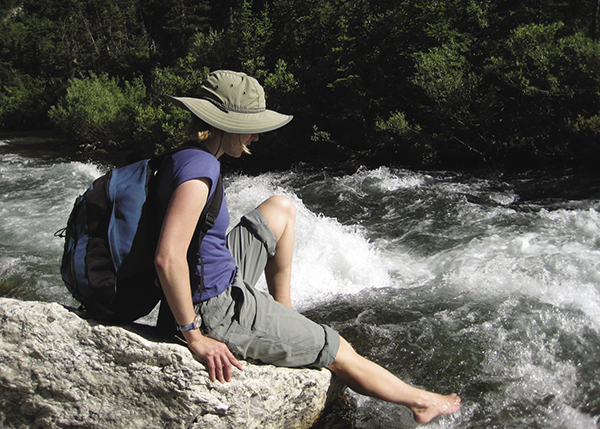
Cooling off during a grand hike. Marnie Schneider
Afterword: The Value of Guidebooks
It has been whispered here and there—usually by “locals”—that books like this are a bad idea. The theory goes something like this: Guidebooks bring more people into the wilderness; more people cause more environmental damage, and the wildness we all seek gradually evaporates.
I used to think like that, too. And here’s why I changed my mind.
When I wrote and published my first guidebook in 1979 (Hiking Montana), some of my hiking buddies disapproved. Since then, I’ve published nearly a hundred hiking guides, and I’m very proud of it. I also hope these books have greatly increased wilderness use.
Experienced hikers tend to have a lofty attitude toward the inexperienced masses. They think anybody who wants to backpack can buy a topo map and compass and find their own way through the wilderness. But the fact is most beginning hikers want a guide. Sometimes new hikers prefer a real, live guide to show them the way and help them build confidence, but most of the time they can get by with a trail guide like this one.
All FalconGuides (and most guidebooks published by other publishers) encourage wilderness users to respect and support the protection of wild country. Sometimes, this is direct editorializing. Sometimes, this invitation takes the more subtle form of simply helping people experience wilderness. And it’s a rare person who leaves the wilderness without a firmly planted passion for wild country—and a desire to vote for more of it.
In classes on backpacking taught for the Yellowstone Institute, I have taken hundreds of people into the wilderness. Many of them had on a backpack for the first time. Many of them were not at first convinced that we need more wilderness, but they were all convinced when they arrived back at the trailhead. Many, many times, I’ve seen it happen without saying a single word about wilderness.
It doesn’t take preaching. Instead, we just need to get people out into the wilderness where the essence of wildness sneaks up on them and takes root—before you know it, the ranks of those who support wilderness has grown.
But what about overcrowding? Yes, it’s a problem in many places and probably is in parts of Grand Teton National Park. The answer to overcrowded, overused wilderness is not limiting use of wilderness and restrictive regulations. The answer is more wilderness. A trampled campsite can be rested and reclaimed, but once roads are built and cabins go up, the land no longer qualifies for wilderness designation.
How can we convince people to support more wilderness when they have never experienced wilderness? In my opinion, we can’t. Without the support of people who experience wilderness, there will be no more wilderness.
That’s why we need guidebooks. And that’s why I changed my mind. I believe guidebooks have done as much to build support for wilderness as pro-wilderness organizations have ever done through political and public relations efforts.
And if that’s not enough, here’s another reason. All FalconGuides (and again, most guidebooks from other publishers) contain sections on leave-no-trace ethics and wilderness safety. Guidebooks provide an ideal medium for communicating such vital information.
In forty years of backpacking, I have seen dramatic changes in how backpackers care for wilderness. I’ve seen it go from appalling to exceptional. Today, almost everybody walks softly in the wilderness. And I believe the information contained in guidebooks has been partly responsible for this change.
Having said all that, I hope many thousands of people use this book to enjoy a fun-filled vacation hiking in Grand Teton National Park—and then, of course, vote for wilderness preservation the rest of their lives.

Cooling off during a grand hike. Marnie Schneider